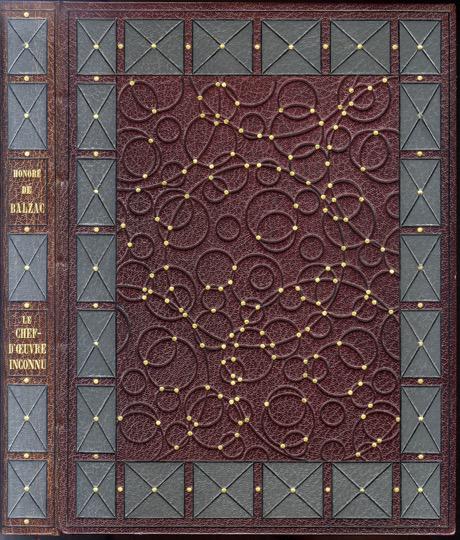Picasso, Pablo (1881-1973) - Balzac, Honoré de (1799-1850). Le Chef-D'oeuvre Inconnu. Paris, Ambroise Vollard, 1931.




Picasso, Pablo (1881-1973) - Balzac, Honoré de (1799-1850). Le Chef-D'oeuvre Inconnu. Paris, Ambroise Vollard, 1931.
Picasso, Pablo (1881-1973) - Balzac, Honoré de (1799-1850).
Le Chef-D'oeuvre Inconnu.
Paris, Ambroise Vollard, 1931.
Picasso’s true meditation on Art
Picasso, Pablo (1881-1973) - Balzac, Honoré de (1799-1850).
Le Chef-D'oeuvre Inconnu. Paris, Ambroise Vollard, 1931.
4° (335x260 mm). XIV, [3], [16 pages lettered A to P], [3], 92, [14] pages. With thirteen original etchings by Picasso, pulled by Louis Fort; sixty-seven wood engravings cut by George Aubert after Picasso's drawings; and 16 pages reproducing lineblock dot and line drawings. Handsomely bound in a custom binding by René Kieffer, with his signature on the lower turn-ins of the upper cover and his stamp pasted on the verso of the second flyleaf. Linen pastedowns, linen and marble-paper flyleaves. In marbled slipcase. Small stain on plate no. V of the table of etchings and on facing page (a blank), otherwise in pristine condition.
Beautiful centennial edition of Balzac's short story, Le Chef-d'oeuvre inconnu – originally published in the newspaper L'Artiste in August 1831 with the title 'Maître Frenhofer' – commissioned by Picasso's dealer, Ambroise Vollard, and illustrated with thirteen original etchings by the Spanish master, sixty-seven wood engravings cut by George Aubert after his drawings, and sixteen pages reproducing lineblock dot and line drawings. This edition was printed in 305 copies, of which 240 – including the present one, no. 230 – were printed on Rives wove paper.
Admired by such artists as Paul Cézanne and Henri Matisse, Balzac's story tells the tale of an ageing seventeenth-century artist named Frenhofer who obsessively works on a canvas he keeps hidden for years. When two young painters and admirers of Frenhofer's work finally manage to see the canvas, they are shocked by what they discover to be an indistinguishable mass of tangled brushstrokes and layers of paint. Deciding that the older artist must have gone insane, the two young artists deride Frenhofer who subsequently destroys all his works and commits suicide.
The story of this dramatically misunderstood yet visionary hero was well suited for the avant-garde artists pursuing careers in Balzac's wake; indeed, in 1904 Cézanne exclaimed outright 'Frenhofer, c'est moi' (J. Medina, Cézanne and Modernism: The Poetics of Painting, 1995). Arguably the most innovative and ground-breaking artist of the Modern period, Picasso was no exception and identified heavily with Balzac's tragic protagonist, so much so that he later moved his studio to the very seventeenth-century townhouse believed to have been the setting for the opening scene of Frenhofer's tale. It is perhaps hardly a coincidence that the dealer of both Cézanne and Picasso was the great avant-garde champion and mentor Ambroise Vollard, who, in addition to dealing art, was also an avid collector, biographer, and publisher.
In 1927, twenty-six years after mounting Picasso's first Paris exhibition in 1901, Vollard asked the Spanish artist to illustrate a centennial edition of Balzac's text. Although Picasso – widely recognized as one of the greatest printmakers of all time – counts among the most prolific book illustrators of the twentieth century, the etchings he produced for this edition in fact bear little relation to Balzac's text; rather, the artist seems to have used the opportunity to reflect more generally on one of his favourite subjects: the artist-model relationship and the act of creation itself. It is perhaps for this reason that the final product – a true meditation on Art – is itself a work of art, ranking among one of the most beautiful artist's books of the twentieth century.
Cramer, Picasso. Catalogue raisonné des livres illustrés, no. 20; Bonet, Carnets, no. 690, pl. 175; Philobiblon, One Thousand Years of Bibliophily, no. 283.



